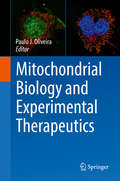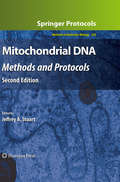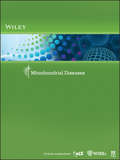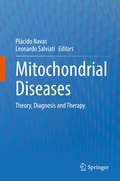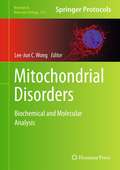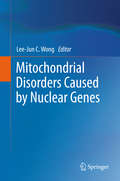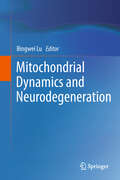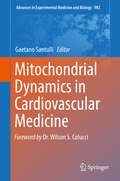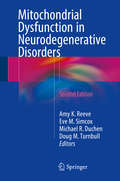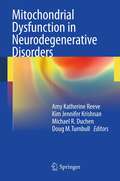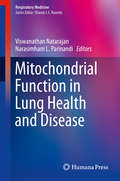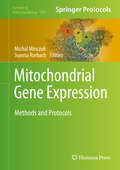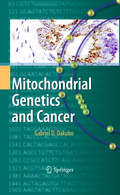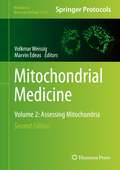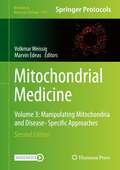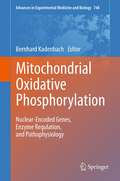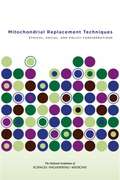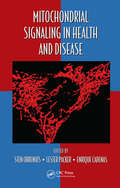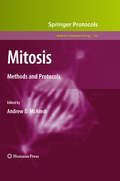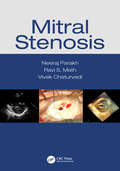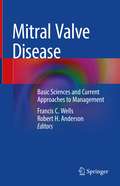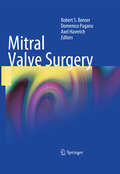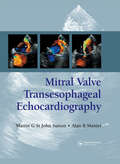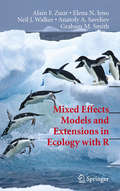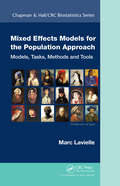- Table View
- List View
Mitochondrial Biology and Experimental Therapeutics
by Paulo J. OliveiraThis book addresses the therapeutic strategies to target mitochondrial metabolism in diseases where the function of that organelle is compromised, and it discusses the effective strategies used to create mitochondrial-targeted agents that can become commercially available drug delivery platforms. The consistent growth of research focused in understanding the multifaceted role of mitochondria in cellular metabolism, controlling pathways related with cell death, and ionic/redox regulation has extended the research of mitochondrial chemical-biological interactions to include various pharmacological and toxicological applications. Not only does the book extensively cover basic mitochondrial physiology, but it also links the molecular interactions within these pathways to a variety of diseases. It is one of the first books to combine state-of-the-art reviews regarding basic mitochondrial biology, the role of mitochondrial alterations in different diseases, and the importance of that organelle as a target for pharmacological and non-pharmacological interventions to improve human health. The different chapters highlight the chemical-biological linkages of the mitochondria in context with drug development and clinical applications.
Mitochondrial DNA
by Jeffrey A StuartSince the publication of the first edition, the number of unique heritable mtDNA mutations recognized as being associated with bioenergetic dysfunction, cell death and disease has grown. Likewise, our understanding of the basic biology of somatic mtDNA mutations continues to improve. In Mitochondrial DNA: Methods and Protocols, Second Edition, specialists from eight countries share their expertise, providing detailed protocols for studying many aspects of mtDNA. The volume is divided into three sections, which cover the transduction of information from mtDNA to functionally active respiratory complexes, mitochondrial reactive oxygen species (ROS) production as well as mtDNA damage and its repair, and the identification and quantification of heteroplasmic mtDNA mutations. Written in the highly successful Methods in Molecular BiologyTM series format, chapters include introductions to their respective topics, lists of the necessary materials and reagents, step-by-step, readily reproducible laboratory protocols, and notes sections, highlighting tips on troubleshooting and avoiding known pitfalls. Comprehensive and authoritative, Mitrochondrial DNA: Methods and Protocols, Second Edition promises to aid researchers in further expanding our knowledge of this vital area of cell biology.
Mitochondrial Diseases (Life Science Research Fundamentals)
by WileyThis collection of reviews and protocols provides the reader with an introduction to the current state of knowledge on how various diseases are related to mitochondrial dysfunction. Mitochondria contain their own genome, a small, circular double-stranded DNA (mtDNA), and alterations in mtDNA may play an important role in the multistep carcinogenesis of at least some types of human cancer. In addition to mutations of mtDNA, many mitochondrial syndromes are due to abnormalities in nuclear genes related to oxidative phosphorylation (OXPHOS). Mitochondrial tRNA (MTT) gene mutations are an important cause of human morbidity and are associated with a wide range of pathology, from isolated organ?]specific diseases such as myopathy or hearing loss, to multisystem disorders with encephalopathy, gastrointestinal dysmotility, and life?]threatening cardiomyopathy. The relationship of the mitochondrion organelle to aging and longevity is also discussed. Laboratory protocols describe methodology to characterize mtDNA heteroplasmy by parallel sequencing. Each eukaryotic cell contains hundreds of mitochondria with hundreds of mitochondria genomes. Mutant and wild-type mtDNA may co-exist as heteroplasmy, and cause human disease. The purpose of this protocol is to simultaneously determine mtDNA sequence and quantify the heteroplasmic level. Another protocol describes procedures for obtaining tissue sections and cell material suitable for histological evaluation of OXPHOS activity and integrity and immunodetection of the complexes in tissue from patients suspected of mitochondrial disease. Emphasis lies on the diagnostic potential of these techniques to differentiate mtDNA from nuclear mutations. This e-book — a curated collection from eLS, WIREs, and Current Protocols — offers a fantastic introduction to the field of mitochondrial diseases for students or interdisciplinary collaborators.
Mitochondrial Diseases: Theory, Diagnosis and Therapy
by Plácido Navas Leonardo SalviatiMitochondrial diseases comprise a clinically and genetically heterogeneous group of rare disorders that may affect virtually any system of the body at any age. Due to their complexity, understanding and diagnosing these diseases requires a multidisciplinary approach.This book provides an update on the major features of human mitochondrial diseases: genetic bases, pathophysiology, diagnosis, and treatment, and of the new technologies involved in the diagnosis and on the characterization of patients. The 11 chapters examine the unique complex interactions between the mitochondrial and the nuclear genomes involved in the biogenesis and the regulation of the mitochondrial respiratory chain, and their relevance to human disease. We discuss the traditional biochemical and genetic approaches, as well as the new omic technologies, and the cellular and animal models used in mitochondrial research. The last chapter is dedicated to the current treatment options.Authors are worldwide experts in these fields and integrate expertise in both basic science and clinical research.This book is particularly important for both scientists and clinicians interested in the diagnosis and treatment of these diseases.
Mitochondrial Disorders
by Lee-Jun C. WongDue to the complexity of the mitochondrial system and the myriad genes involved in their function, the clinical manifestations of mitochondrial diseases are remarkably variable and heterogeneous. The laboratory and clinical methodologies used to evaluate dysfunction may vary widely, and thusly a systematic presentation of the numerous protocols that are applied to the assessment of these clinically and genetically heterogeneous disorders has proven to be essential. Mitochondrial Disorders: Biochemical and Molecular Analysis strives to fill this need with a collection of key protocols provided by leading experts in the field. Beginning with overviews of complexity of mitochondrial and nuclear genome disorders, the book continues with a section devoted to current biochemical protocols and a part focused on the DNA-based approaches used to identify molecular defects. Written in the highly successful Methods in Molecular BiologyTM series format, chapters contain introductions to their respective topics, lists of the necessary materials and reagents, step-by-step, readily reproducible laboratory protocols, and tips on troubleshooting and avoiding known pitfalls. Detailed and authoritative, Mitochondrial Disorders: Biochemical and Molecular Analysis serves as a vital guide to researchers seeking to understand this incredibly complicated type of breakdown in cellular biology.
Mitochondrial Disorders Caused by Nuclear Genes
by Lee-Jun C. WongMitochondrial cytopathies are mutations in the inherited maternal mitochondrial genome, or the nuclear DNA-mutation. Mitochondrial respiratory chain disorders (RCD) are a group of genetically and clinically heterogeneous diseases, due to the fact that protein components of the respiratory chain are encoded by both mitochondrial and nuclear genomes and are essential in all cells. In addition, the biogenesis, structure and function of mitochondria, including DNA replication, transcription, and translation, all require nuclear encoded genes. Since mitochondria are present in every cell, every tissue, mitochondrial disorder usually affects multiple organs.
Mitochondrial Dynamics and Neurodegeneration
by Bingwei LuMitochondria are essential organelles in eukaryotic cells that control such diverse processes as energy metabolism, calcium buffering, and cell death. Recent studies have revealed that changes in mitochondrial morphology by fission and fusion, a process known as mitochondrial dynamics, is particularly important for neuronal function and survival. Defects in this process are commonly found in neurodegenerative diseases, offering a new paradigm for investigating mechanisms of neurodegeneration. To provide researchers working on neurodegenerative diseases and mitochondria with updated information on this rapidly progressing field, we have invited experts in the field to critically review recent progresses and identify future research directions. The topics include genetics of mitochondrial dynamics, mitochondrial dynamics and bioenergetics, autophagy, apoptosis, and axonal transport, and its role in neurological diseases, including Alzheimer's, Parkinson's, and Huntington's diseases.
Mitochondrial Dynamics in Cardiovascular Medicine
by Gaetano SantulliThis text covers the basic principles of mitochondrial dynamics in cardiovascular medicine, with particular emphasis on their functional roles in physiology and disease. The book will include articles pertaining to mitochondrial fitness on a global basis, providing therefore an update on the progress made in several aspects in the field. Thus, it will assist scientists and clinicians alike in furthering basic and translational research. Organized in sections focusing on: basic science, mitochondrial dysfunction in cardiac disorders, in vascular disorders, in metabolic disorders, in kidney disease, therapeutic challenges and options, this essential volume fills imperative gaps in understanding and potentially treating several cardiovascular disorders.
Mitochondrial Dysfunction in Neurodegenerative Disorders
by Michael R. Duchen Amy K. Reeve Eve M. Simcox Doug M. TurnbullThis second edition brings together up-to-date contributionsfrom leaders in the field internationally on the various ways in whichmitochondrial dysfunction contributes to the pathogenesis of neurodegenerativediseases, including Parkinson's disease, Alzheimer's disease and multiplesclerosis. The reader is guided through the basic functions of mitochondria andthe mechanisms that lead to their dysfunction, and on to the consequences ofthis dysfunction for neuronal function before finishing with the modelling ofthese disorders and discussion of new potential therapeutic targets. Additional chapters have been added to the book to reflectadvances in the field and there are many new contributors and topics, includinghow mitochondria are degraded and the interaction of the mitochondria withpathologically relevant proteins. Mitochondrial Dysfunction in Neurodegenerative Disordersprovides an accessible, authoritative guide to this important area forneurologists; research and clinical neuroscientists; neuropathologists; andresidents with an interest in clinical research.
Mitochondrial Dysfunction in Neurodegenerative Disorders
by Kim Jennifer Krishnan Doug M Turnbull Amy Katherine Reeve Michael R. DuchenAs age related diseases increase in prevalence and impact more significantly on medical resources it is imperative to understand these diseases and the mechanisms behind their progression. New research has stimulated a growing interest in mitochondrial involvement in neurodegenerative disorders such as Parkinson's disease, Alzheimer's disease and multiple sclerosis and the mechanisms which lead from mitochondrial dysfunction to neurodegeneration. Mitochondrial Dysfunction in Neurodegenerative Disorders brings together contributions from leaders in the field internationally on the various ways in which mitochondrial dysfunction contributes to the pathogenesis of these diseases, guiding the reader through the basic functions of mitochondria and the mechanisms that lead to their dysfunction, to the consequences of this dysfunction on neuronal function before finishing with the modelling of these disorders and discussion of new potential therapeutic targets. Mitochondrial Dysfunction in Neurodegenerative Disorders provides an accessible, authoritative guide to this important area for neurologists; research and clinical neuroscientists; neuropathologists; and residents with an interest in clinical research.
Mitochondrial Function in Lung Health and Disease
by Narasimham L. Parinandi Viswanathan NatarajanMitochondria, often referred to as the "powerhouses" of the cell, generate adenosine triphosphate (ATP) by oxidative phosphorylation or OXPHOS, and maintain cellular homeostasis. In addition to generating ATP, mitochondria are involved in regulation of cell cycle, proliferation, free radical production, innate immune responses and apoptosis. Mitochondrial Function in Lung Health and Disease fills the current gap in the literature and outlines the growing clinical relevance of mitochondrial dysfunction Currently, there is no overview on the role of mitochondria in pulmonary diseases and this volume focuses on the mitochondrial metabolism, redox signaling, and mechanisms of mitochondrial pathways in lung injury, inflammation, repair and remodeling Furthermore, in addition to their well-recognized role in cellular energy production and apoptosis, mitochondria appear to play a role in many respiratory diseases and lung cancer. Chapters are written by top notch researchers and clinicians and outline the evidence for mitochondrial biogenesis in inhalational lung injury, COPD and asthma.
Mitochondrial Gene Expression: Methods and Protocols (Methods in Molecular Biology #2192)
by Joanna Rorbach Michal MinczukThis volume details the most recent advancements in the field of mitochondrial gene expression. Chapters guide readers through methods and protocols on mtDNA replication, transcription, and translation to membrane insertion of the mtDNA-encoded protein products. Written in the highly successful Methods in Molecular Biology series format, chapters include introductions to their respective topics, lists of the necessary materials and reagents, step-by-step, readily reproducible laboratory protocols, and tips on troubleshooting and avoiding known pitfalls. Authoritative and cutting-edge, Mitochondrial Gene Expression: Methods and Protocols aims to provide complementary approaches and practical guidelines. Chapter 7 is available Open Access under a Creative Commons Attribution 4.0 International License via link.springer.com.
Mitochondrial Genetics and Cancer
by Gabriel D. DakuboThe pivotal role of mitochondrial functions in carcinogenesis is quite well established. However, the critical role of mitochondrial genome alterations to cancer development is muted in traditional textbooks. Recent scientific efforts have provided unequivocal evidence for mitochondrial genome mutations and content changes in cancer development, progression, and therapy. This pioneering book is a unique compilation of mitochondrial genome alterations in cancer. While primarily focused on the emerging role of mitochondrial genome changes, bioenergetics and signaling pathways, attention is also given to the metabolic transformations of the cancer cell, as well as the established altered cell death processes that underlie cancer evolution and treatment resistance.
Mitochondrial Medicine: Volume 2: Assessing Mitochondria (Methods in Molecular Biology #2276)
by Volkmar Weissig Marvin EdeasThis second edition offers 88 chapters divided among three volumes providing the most comprehensive source of know-how in the wide-ranging field of Mitochondrial Medicine. Volume II guides readers through chapters on mitochondrial dysfunction, functional’ mitochondria, mitochondrial retrograde, mitochondrial dNTP pool quantification, mitochondrial ADP-ribosylation, blue-native gel approach, 3D optical cryo-imaging method, mitochondrial ATP and ROS production, protocol for untargeted metabolomic analysis, and methods for analysis of nitrotyrosine-containing proteins. Written in the highly successful Methods in Molecular Biology series format, chapters include introductions to their respective topics, application details for both the expert and non-expert reader, and tips on troubleshooting and avoiding known pitfalls. Authoritative and accessible, Mitochondrial Medicine, Second Edition, Volume 2: Assessing Mitochondria aims to be a comprehensive source of know-how in the wide-ranging field of Mitochondrial Medicine.
Mitochondrial Medicine: Volume 3: Manipulating Mitochondria and Disease- Specific Approaches (Methods in Molecular Biology #2277)
by Volkmar Weissig Marvin EdeasThis second edition offers 88 chapters divided among three volumes providing the most comprehensive source of know-how in the wide-ranging field of Mitochondrial Medicine. Volume III guides readers through chapters on intercellular mitochondrial transfer, Cytoplasmic transfer methods, Ndufs4 knockout mouse, in vivo assessment of mitochondrial oxygen consumption, mitochondrial network analysis by imaging, mitochondrial respiration in platelets, Heterologous Inferential Analysis (HIA), bioenergetic profiling, integrative methods for studying cardiac energetics, and isolation and deep sequencing of mitochondrial DNA.Written in the highly successful Methods in Molecular Biology series format, chapters include introductions to their respective topics, application details for both the expert and non-expert reader, and tips on troubleshooting and avoiding known pitfalls. Authoritative and accessible, Mitochondrial Medicine, Second Edition, Volume 3: Manipulating Mitochondria and Disease- Specific Approaches aims to be a comprehensive source of know-how in the wide-ranging field of Mitochondrial Medicine.
Mitochondrial Oxidative Phosphorylation
by Bernhard KadenbachThis book will describe the nuclear encoded genes and their expressed proteins of mitochondrial oxidative phosphorylation. Most of these genes occur in eukaryotic cells, but not in bacteria or archaea. The main function of mitochondria, the synthesis of ATP, is performed at subunits of proton pumps (complexes I, III, IV and V), which are encoded on mitochondrial DNA. The nuclear encoded subunits have mostly a regulatory function. However, the specific physiological functions of the nuclear encoded subunits of complexes I, III, IV, and V are mostly unknown. New data indicates that they are essential for life of higher organisms, which is characterized by an adult life without cell division (postmeiotic stage) in most tissues, after the juvenile growth. For complex IV (cytochrome c oxidase) some of these subunits occur in tissue-specific (subunits IV, VIa, VIb, VIIa, VIII), developmental-specific (subunits IV, VIa, and VIIa) as well as species-specific isoforms. Defective genes of some subunits were shown to induce mitochondrial diseases. Mitochondrial genes and human diseases will also be covered.
Mitochondrial Replacement Techniques: Ethical, Social, and Policy Considerations
by Engineering Medicine National Academies of SciencesMitochondrial replacement techniques (MRTs) are designed to prevent the transmission of mitochondrial DNA (mtDNA) diseases from mother to child. While MRTs, if effective, could satisfy a desire of women seeking to have a genetically related child without the risk of passing on mtDNA disease, the technique raises significant ethical and social issues. It would create offspring who have genetic material from two women, something never sanctioned in humans, and would create mitochondrial changes that could be heritable (in female offspring), and therefore passed on in perpetuity. The manipulation would be performed on eggs or embryos, would affect every cell of the resulting individual, and once carried out this genetic manipulation is not reversible. Mitochondrial Replacement Techniques considers the implications of manipulating mitochondrial content both in children born to women as a result of participating in these studies and in descendants of any female offspring. This study examines the ethical and social issues related to MRTs, outlines principles that would provide a framework and foundation for oversight of MRTs, and develops recommendations to inform the Food and Drug Administration’s consideration of investigational new drug applications.
Mitochondrial Signaling in Health and Disease (Oxidative Stress and Disease)
by Enrique Cadenas Lester Packer Sten OrreniusMitochondria have traditionally been associated with metabolic functions; however recent research has uncovered a central role for these organelles in cell signaling, cell survival, and cell death. Mitochondrial dysfunction is a factor in a myriad of pathophysiological conditions, including age-related neurodegenerative disorders, cancer, metabolic
Mitosis
by Andrew D. McainshWith the advent of modern methodology, the phenomenal complexity of the protein components and regulatory steps involved in mitosis has become approachable. In Mitosis: Methods and Protocols, experts in the field provide an up-to-date collection of methods and approaches that are used to investigate the mechanism of mitosis at the molecular level. Ideal for both experienced and novice scientists, the volume includes step-by-step methods covering inactivation of genes of interest, depletion of proteins of interest, biochemical and microscope-based techniques, and procedures to monitor and measure key mitotic processes. Written in the highly successful Methods in Molecular BiologyTM series format, chapters include brief introductions to the respective topics, lists of the necessary materials and reagents, readily reproducible laboratory protocols, and notes on troubleshooting and avoiding known pitfalls. Comprehensive and authoritative, Mitosis: Methods and Protocols combines imaging, biochemical, and genetic methodologies in order to best guide researchers in their attempts to better understand the crucial processes of mitotic regulation.
Mitral Stenosis
by Neeraj Parakh Ravi S Math Vivek ChaturvediComprehensive book on mitral stenosis not only compiles the existing published knowledge and literature about mitral stenosis in a succinct manner but also has input from experts having years of experience in this field. It will serve as an authentic reference and a ready reckoner for cardiology fellows, practicing cardiologists, academics and researchers
Mitral Valve Disease: Basic Sciences and Current Approaches to Management
by Robert H. Anderson Francis C. WellsThis book provides a comprehensive review of the basic science of the mitral valve needed to begin to comprehend both normal and the failing valve. This knowledge is infrequently discussed in the clinical arena, with a rush towards definition of lesions based on limited analysis. It provides a ready single source of the most important basic science subjects pertaining to the valve, and the pathologies found therein, and thus a more complete understanding of the factors that result in dysfunction may be appreciated. Mitral Valve Disease: Basic Sciences and Current Approaches to Management includes chapters on embryology and anatomy, including details of structural, comparative and functional features. Since the valve is completely influenced by genetics and molecular biology, subjects rarely if ever addressed in the clinical arena, these topics receive in-depth attention. Coverage concludes with lengthy discussions of the importance of multi-disciplinary work, along with the importance of the electrophysiological disturbances encountered in some groups of these patients. It therefore is an essential and up-to-date resource for the practicing and trainee cardiac surgeon and any researcher working within this topic.
Mitral Valve Surgery
by Robert S. Bonser Domenico Pagano Axel HaverichPart of the Monographs in Cardiac Surgery Series - Introducing 'basic science into the cardiac operating room'. Fast systematic review of small areas of cardiac surgery including up-to-date information. This will allow more rapid publication than the alternative cardiac surgery 'tomes'. This entry into the series will provide readers with a complete review of the current understanding in mitral valve surgery and include extensive details on the diagnosis and surgical management of patients with mitral valve disease.
Mitral Valve Transesophageal Echocardiography
by Martin G. St. John Sutton Alan R. ManietThe only book available on transesophageal echocardiography of the mitral valve, this impressive and highly illustrated text provides a concise yet in-depth analysis of the mitral valve from an experience of over 10,000 transesophageal echocardiograms performed by the authors.A starting point or 'how-to' reference for studying the mitral valve
Mixed Effects Models and Extensions in Ecology with R
by Neil Walker Elena N. Ieno Graham M. Smith Anatoly A. Saveliev Alain ZuurThis book discusses advanced statistical methods that can be used to analyse ecological data. Most environmental collected data are measured repeatedly over time, or space and this requires the use of GLMM or GAMM methods. The book starts by revising regression, additive modelling, GAM and GLM, and then discusses dealing with spatial or temporal dependencies and nested data.
Mixed Effects Models for the Population Approach: Models, Tasks, Methods and Tools (Chapman & Hall/CRC Biostatistics Series)
by Marc LavielleWide-Ranging Coverage of Parametric Modeling in Linear and Nonlinear Mixed Effects ModelsMixed Effects Models for the Population Approach: Models, Tasks, Methods and Tools presents a rigorous framework for describing, implementing, and using mixed effects models. With these models, readers can perform parameter estimation and modeling across a whol
